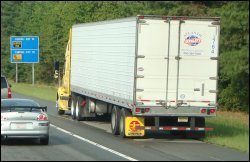When driving a Commercial Motor Vehicle (CMV), the accident possibility and probability increase in direct proportion to the amount of traffic around the CMV. The heavy-duty trucks on the road today are more of a target than a small car. They are easier to hit, they move laterally more slowly, and take up a lot more room. They are an attraction to others drivers’ eyes.
Parking vehicles in the emergency lane is not a recommended procedure unless a viable emergency exists, which means that the truck is broken down and cannot move. There is not practical reason to park a truck in the emergency lane for a non-viable emergency.

Potentially correct uses of the Emergency Lane:
Unable to move: If there is a situation where the CMV cannot move, the driver should immediately get out their emergency reflectors.
Equipment Failure: Stopping because the truck has a viable problem can a reason to park in the emergency lane. Examples include: a broken fuel line, a lost fuel filter, blown front tire or other significant failures.
If the equipment is mobile, then the driver should move to the next off-ramp. Even if they have to move slowly down the emergency lane to reach the off-ramp. They should get out of the emergency lane.
The driver should place the truck in a safe position before they get out. If the truck has a fuel restriction (and this happens), where the fuel filter is limiting horsepower, then the truck should move to the emergency lane and be driven to the next off-ramp, even if is at 35 mph.
Safety First: The fuel filter is usually on the left (road) side of the truck. There is nothing more interesting than having your legs sticking out into the driving lane while you are under the truck working on the fuel filter.

